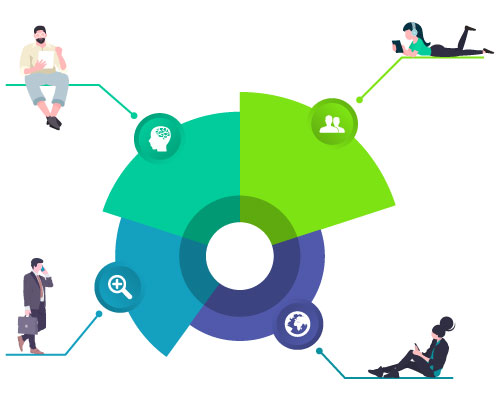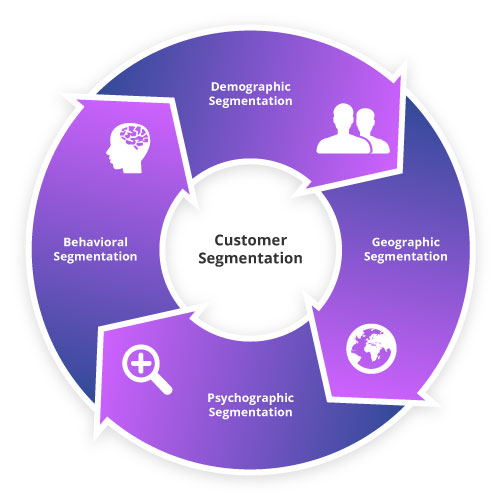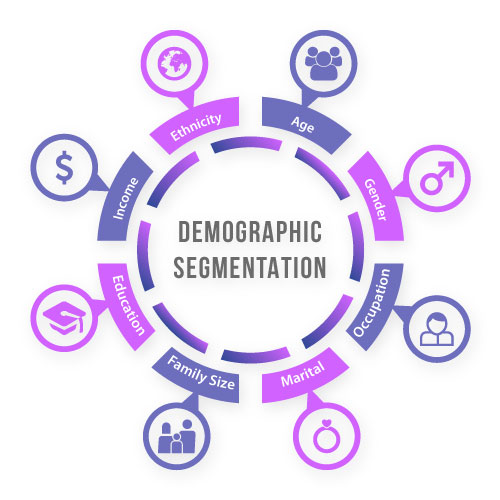What is Customer Segmentation: The word ‘segment’ denotes ‘division,’ i.e. to divide into parts or sections according to similar characteristics. So customer segmentation is dividing the customers effectively, based on their factors such as age, need, industry type or buying features.
It is also known as Market Segmentation
Customer segmentation is essential for the marketer so that the salesman can strategically focus on a specific subgroup of customers rather than a vast potential consumer.

It is essential to talk about the overall significance of customer segmentation for your marketing strategy, especially when you are creating content.
We are going to talk about the overall significance of customer segmentation in your marketing strategy.
Marketing strategies such as pay per click advertising(PPC), Search Engine Optimisation(SEO), email marketing, social media marketing all begin with one common element and that is content. So it’s essential to keep customer segmentation in mind throughout your content brainstorming and creation.
Suppose, you are going to start an email marketing campaign, You need to have customized content for those specific users for better targeting. So you require customer segmentation even in small areas.
Contents
4 Types of Customer Segmentation

1. Demographic Segmentation

The word “Demographic” denotes a particular section of the population, or you can say statistical characteristics of human populations which include age, race, gender, marital status, income, education, and employment. You can divide the consumers based on such factors to enhance your sales potential.
Example: Suppose, A textile company is dealing with woolen wear. They know that different gender or age groups would prefer different fabric types and dresses in woolen. Therefore, you can segment the audience on the basis of gender and age. Further, you can engage them accordingly.
Advantages
- It saves time by selling unnecessary things to potential consumers.
- Targeting specific audiences improve customer retention and loyalty.
- The marketer can modify their product or service in less time to suit the needs of the target segment.
Disadvantages
- It involves limited production because customers are limited in each segment.
- It is expensive because the cost of production rises due to shorter production runs and product variations.
2. Geographic Segmentation

It means dividing customers on the basis of geographic location, i.e. latitudes and longitudes. When an industry split its market on the basis of geographical areas such as city, country, state or region. The industry, at times, divides into rural, urban and suburban market segments depending on the type of business segment. At times the market is also divided on the basis of climate or total population.
Example: A UK brand clothing company ‘Superdry’ sells funky T-shirts, trousers, swimwear in Mumbai(India) in the month of November, whereas it sells blazers, trench coats, long coats in London(UK) during the same time.
One brand can sell different sorts of clothes on the basis of the weather condition of the specific state of the country.
Advantages
- Since geographics are well defined through borders, population, density, topography, etc., it becomes easier for companies to identify the needs of the potential customers and produce accordingly.
- Companies identify people with similar needs and preferences with the help of geographic segments.
- Densely populated areas lead to huge market potential and a company can earn more profit by offering a wide range of products or services.
Disadvantages
- You can only predict the weather but cannot be sure about it as it keeps on changing. So it becomes risky at times for companies, who engage their segments according to geographic weather patterns.
- It does not focus on the buying behavior pattern of consumers. People living in the same region can have different needs and desires. Thus, can result in different buying patterns.
3. Psychographic Segmentation

It denotes grouping of target segments, whether prospective, past customers or current customers based on their beliefs, traits, attitude, aura, interest, lifestyle, social class, and many other factors. Analyzing such traits and grouping them together is the art of the Psychographic segment. By understanding psychographics, marketers can develop content that is more relatable to customer segments.
Example: Suppose a textile company intends to design clothes for various sections of the market such as athletes, office-goers, students, etc. They can divide groups according to their lifestyle- such as athletes will prefer sportswear or gym wear and the office goers will intend to wear formal clothes. This way, the manufacturer can produce clothes to cater to the needs of each customer.
For example, an Athlete Management System can help track athletes’ preferences and performance data, allowing manufacturers to design apparel that enhances comfort and functionality.
Advantages
- It gives due importance to consumer preferences, beliefs, and thought processes. It understands customer concerns.
- A researcher not only fulfills consumer needs but also creates a sense of satisfaction and loyalty amongst them by catering to varied activities, interests, and opinions.
- This segment proves best when you involve customization of products and services.
Disadvantages
- The implication of this segment is difficult as compared to demographic and geographic segments.
- It can cover a limited number of potential consumers at a time.
4. Behavioral segmentation

As the name suggests, this segment divides consumers according to behavior patterns as they interact with a company. Their main objective is to address the particular needs and desires of customer groups and tailor the product or service to meet those needs.
Example: The latest fashion designers such as Sabyasachi, House of Masaba, Vedika M, where clothes are customizing and tailoring the clothes on the basis of customer’s needs and desires. They customize dresses according to the orders made by the client.
Advantages
- Behavioral segmentation allows brands to use valuable time and resources more efficiently.
- It helps to develop smart marketing strategies to improve and expand the customer base.
- It promotes behavioral patterns that help in predicting customer’s behavior and outcomes.
Disadvantages
- The behavior of people never remains the same, and it keeps on changing. This is the reason marketers do not prefer such a strategy.
- It covers a limited number of potential consumers.
- It cannot be measured easily, or in other words, it is qualitative and cannot be quantified due to its subjective nature. So one cannot justify it with figures or estimates as far as the behavior of the consumers is concerned.
Therefore, companies can become more familiar with consumer needs by using segmentation types and tailor-made their pricing strategies accordingly.
How Can Segmentation Benefit Your Business?

Segmentation allows you to make better use of market strategies, as well as be efficient in terms of time, money and resources. Marketers can gain a better understanding of the needs and preferences of consumers. So the result is growth in sales with a cost-effective strategy.
Customer segmentation enhances customer credibility and allows you to focus on important things. Also, it helps you to engage the customers with the right thing at the right time and with the right quality.
Conclusion
Companies would not survive in the long run if the marketing strategy is dependent upon targeting a massive population. Even email marketing requires customer segmentation for perfect targeting. It allows a business to precisely cater to customer needs and preferences across different parts of the world.
Thus, customer segmentation is always a good idea? If not, can you please tell me what idea is best for you to target potential consumers from different parts of the world in the comment section?
Also Read:

























 Email
Email SMS
SMS Whatsapp
Whatsapp Web Push
Web Push App Push
App Push Popups
Popups Channel A/B Testing
Channel A/B Testing  Control groups Analysis
Control groups Analysis Frequency Capping
Frequency Capping Funnel Analysis
Funnel Analysis Cohort Analysis
Cohort Analysis RFM Analysis
RFM Analysis Signup Forms
Signup Forms Surveys
Surveys NPS
NPS Landing pages personalization
Landing pages personalization  Website A/B Testing
Website A/B Testing  PWA/TWA
PWA/TWA Heatmaps
Heatmaps Session Recording
Session Recording Wix
Wix Shopify
Shopify Magento
Magento Woocommerce
Woocommerce eCommerce D2C
eCommerce D2C  Mutual Funds
Mutual Funds Insurance
Insurance Lending
Lending  Recipes
Recipes  Product Updates
Product Updates App Marketplace
App Marketplace Academy
Academy

